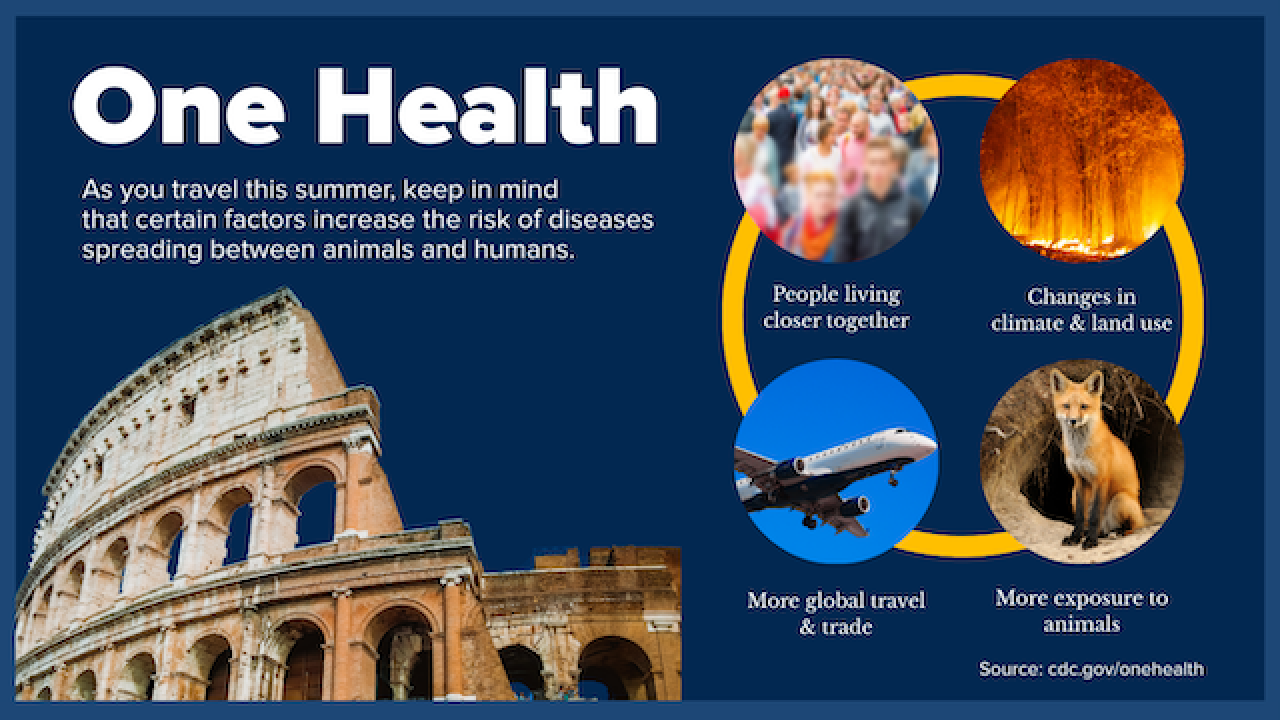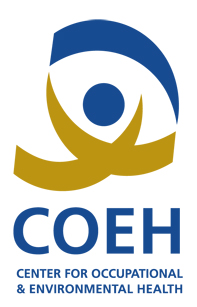
Why One Health Should Be On Your Packing List This Summer
Quick Summary
- One Health is the collaborative, multisectoral, and transdisciplinary approach to environmental health that recognizes the interconnection between people, animals, and plants.
- Mirjana Susa, MPH explains how it all works in real life.
You check your inbox to see your flight confirmation number come through. You’re elated and immediately call your mom to tell her the good news. You’ve recently received a promotion after working in a public health administration position for two years, and you just finished season two of The White Lotus, so why not book a trip to Italy? You’ve always wanted to eat authentic pizza and walk around with gelato and make vague, Italian hand gestures. You comb through your apartment and find your passport. Still valid. Phew.
Now you start planning. You remember that it gets warm in the summer in Italy and look up how you can prepare ahead of time. You find a Reddit post that says you absolutely need mosquito repellant. Add to cart.
Your public health brain kicks in and you go down a rabbit hole about mosquitos. You remember hearing about West Nile virus in class, but what exactly was it again?
You come across the U.S. Centers for Disease Control and Prevention (CDC) West Nile page and read that it spreads when mosquitos feed on infected birds and then bite people. Symptoms include fever, headache, body aches, vomiting, diarrhea, and/or rash. There are no preventative vaccines or treatments for it. Spooky.
You also land on the European Centre for Disease Prevention and Control (ECDC) page and see that human infections of West Nile have been reported in Italy last year. You even faintly remember reading a New York Times article by former Chief Medical Advisor Dr. Anthony Fauci who described his own infectious experience as “terrifying” from “a disease that, for many people, can have devastating and permanent consequences.” Time to be vigilant.
You’ve finally arrived at the airport. You’re waiting to board the plane, and you’re watching the airport crew prepare diligently for takeoff. You become curious about the minutiae of air travel and decide to search how much carbon emissions are generated from a San Francisco to Rome flight, roundtrip.
A total of 2,446 pounds of CO2 per person for the journey, if flying economy, according to the carbon emissions calculator on the International Civil Aviation Organization (ICAO) website. Interestingly, the emissions number jumps up to 9,410 pounds if flying first class. Apparently, flying behind the first-class curtain means more than just a difference in your bank account balance.
The entire topic gets you ruminating on carbon footprints and the overarching global effects of climate change. Wait, wasn’t there an article from the U.S. Environmental Protection Agency (EPA) about climate change indicators and West Nile Virus? Oh, right, the one that says that warmer temperatures can expedite mosquito development, bite rates, and viral incubation periods in mosquitos, as well as alter bird migration and breeding, all of which can contribute to increased risk of human exposure to West Nile virus?
None of this information helps your pre-flight jitters, but not to worry. The kind employees at the CDC have assembled a list of personal protective measures, including the use of mosquito repellants (check), long-sleeved clothing (check), and limiting time outdoors around dusk and dawn (check).
You also read an article that mentioned that you can be a good public health citizen by looking out for sick or dead birds and reporting them to your respective health department, such as through the California Department of Public Health’s Vector-Borne Disease Section. And now you hear your boarding group number called. Time to go.
Congratulations, you’ve just completed a scenario in One Health! The World Health Organization defines One Health as the “integrated, unifying approach that aims to sustainably balance and optimize the health of people, animals and ecosystems.” Think of it as a coordinated flight plan to keep all passengers on Earth safe and well.
While the connection between human and animal infections is not new, understanding public health issues this way didn't start until the 20th Century. Dr. Calvin Schwabe, a veterinarian and the founding Chair of the Department of Epidemiology and Preventive Medicine at UC Davis (now the Department of Public Health Sciences), created the term “One Medicine” in his 1964 textbook Veterinary Medicine and Human Health.
One Medicine called upon the medical and veterinary fields to cooperate in the fight against zoonotic diseases which affect both humans and animals and make up most emerging infectious diseases (60%). One Health took it a step further by integrating the ecosystems where animals and humans live into this framework.
For researchers, it’s important to continue looking at public health through a One Health lens, especially in the post-COVID-19 world. Doing so could save human and animal lives, as well as reduce costs. Moreover, climate change is linked to rises in infectious diseases, resulting in global economic losses from outbreaks, natural disasters, and delayed or discontinued trade.
The good news is that the concept of One Health is becoming more popular over time, with a growth in published research of over 600% from 2012 to 2021. One Health has become so popular that UC Davis now hosts its own One Health Institute.
The team at the UC Davis Center for Occupational and Environmental Health recognizes the importance of interdisciplinary, multisectoral work. We know that protecting the people around us includes protecting animals and ecosystems as well.
We’re currently working on projects that connect greenspace and health data and hope this research will reach policymakers and organizations that can take steps towards promoting environmental health. By addressing the negative effects of climate change, like more frequent and intense wildfires in California and exposure to extreme heat, we can help create healthier spaces for ourselves and the animals around us.
We look forward to collaborating with current and future leaders in medicine, veterinary medicine, public health, epidemiology, environmental sciences, and so much more to support our mission of fostering valuable knowledge and resources for healthy workplaces and communities.
Mirjana Susa, MPH is COEH's Research Grant Program Officer. She has degrees in animal science and epidemiology and played a leading role in the Healthy Davis Together COVID-19 project.
Media Resources
Source List
- West Nile virus. Centers for Disease Control and Prevention. Accessed May 7, 2025. https://www.cdc.gov/west-nile-virus/index.html.
- Weekly updates: 2024 west nile virus transmission season. European Centre for Disease Prevention and Control. November 8, 2024. Accessed May 7, 2025. https://www.ecdc.europa.eu/en/west-nile-fever/surveillance-and-disease-data/disease-data-ecdc.
- Fauci A. Anthony Fauci: A Mosquito in My Backyard Made Me the Sickest I’ve Ever Been. The New York Times. https://www.nytimes.com/2024/10/07/opinion/fauci-west-nile-virus.html. Published October 7, 2024. Accessed May 7, 2025.
- CAO Carbon Emissions Calculator (ICEC). International Civil Aviation Organization. Accessed May 7, 2025. https://www.icao.int/environmental-protection/Carbonoffset/Pages/default.aspx.
- Climate Change Indicators: West Nile Virus. United States Environmental Protection Agency. February 4, 2025. Accessed May 7, 2025. https://www.epa.gov/climate-indicators/climate-change-indicators-west-nile-virus.
- Treatment and Prevention of West Nile Virus Disease. U.S. Centers for Disease Control and Prevention. Accessed May 7, 2025. https://www.cdc.gov/west-nile-virus/hcp/treatment-prevention/index.html#:~:text=Personal%20protective%20measures%20include%20use,the%20risk%20for%20WNV%20exposure.
- American Society for Microbiology. FAQ: West Nile Virus. Washington, DC: American Society for Microbiology; 2013. Available at: https://www.ncbi.nlm.nih.gov/books/NBK562891/. doi:10.1128/AAMCol.3-2013. Accessed May 7, 2025.
- Report a Dead Bird. California Department of Public Health Vector-Borne Disease Section. Accessed May 7, 2025. https://westnile.ca.gov/report.php.
- One Health. World Health Organization. Accessed May 7, 2025. https://www.who.int/health-topics/one-health#tab=tab_1.
- One Health History. U.S. Centers for Disease Control and Prevention. Accessed May 7, 2025. https://www.cdc.gov/one-health/about/one-health-history.html.
- Environment and One Health. World Health Organization. July 18, 2023. Accessed May 7, 2025. https://www.who.int/europe/news-room/fact-sheets/item/environment-and-one-health.
- Zinsstag J, Schelling E, Waltner-Toews D, Tanner M. From "one medicine" to "one health" and systemic approaches to health and well-being. Prev Vet Med. 2011;101(3-4):148-156. doi:10.1016/j.prevetmed.2010.07.003. Accessed May 8, 2025. https://www.sciencedirect.com/science/article/pii/S0167587710002023?via%3Dihub
- Shafique M, Khurshid M, Muzammil S, et al. Traversed dynamics of climate change and One Health. Environmental Sciences Europe. 2024;36(1):135. doi:10.1186/s12302-024-00931-8. Accessed May 12, 2025. https://enveurope.springeropen.com/articles/10.1186/s12302-024-00931-8
- Qiang N, Gu SY, Wang XY, et al. A One Health information database based on standard bibliometric analysis. Sci One Health. 2023;1:100012. Published 2023 Mar 1. doi:10.1016/j.soh.2023.100012. Accessed May 8, 2025. https://www.sciencedirect.com/science/article/pii/S2949704323000069
- One Health Institute. UC Davis School of Veterinary Medicine. Accessed May 7, 2025. https://ohi.vetmed.ucdavis.edu/.
- Center for Occupational and Environmental Health. UC Davis. Accessed May 7, 2025. https://coeh.ucdavis.edu/.
- Wildfires & Climate Change. California Air Resources Board. Accessed May 8, 2025. https://ww2.arb.ca.gov/wildfires-climate-change.
